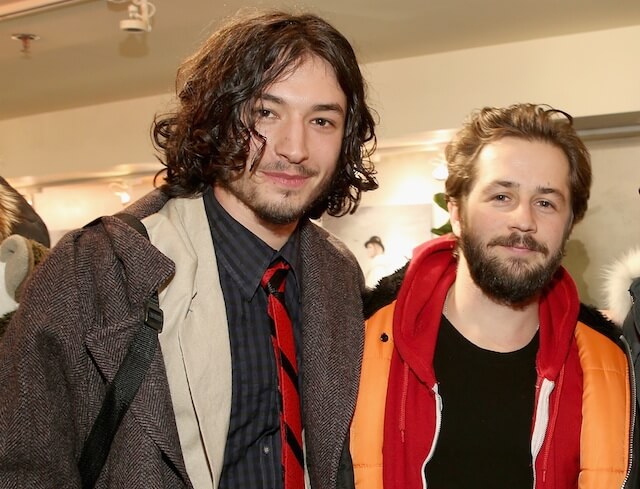You wouldn’t think it, but actors Ezra Miller and Michael Angarano had a blast shooting “The Stanford Prison Experiment.” The real-life incident, held over six days in 1971, involved 24 young men, randomly divided into inmates and guards, simulating a prison experience — only to have it quickly spiral out of control. But while making the new film recreation, the actors — also including Tye Sheridan, Thomas Mann, Jack Kilmer, plus Billy Crudup as the instigator, Dr. Philip Zimbardo — easily slipped in and out of characters without coming close to going beyond Method. In fact, Miller and Angarano — who play the most sensitive inmate, respectively and the most sadistic guard, respectively — couldn’t be having more fun talking about it, saying they laugh when journalists assume they’re “haunted” by the shoot. Well, are you haunted? Michael Angarano: No, not even close. Actually the complete opposite of being traumatized.
Ezra Miller: Strangely enough, making this movie was, I would say, incontestably a really fun, wonderful experience.
MA: Most of these guys are good friends of mine — not even friends, good friends. And we got to really be part of something by recreating this crazy story.
EM: And we got to manifest our neuroses together.
Did it almost feel like drama camp?
EM: Totally. Definitely summer camp for 20somethings.
MA: And you get great material. Since we all knew each other there was no limit to how far we could go. We were able to do that, but without taking it or ourselves too seriously.
EM: Which has clearly all fallen through now, in the press stage.
MA: This dynamic was what the set was like.
EM: Times ten, because of the mass of individuals, all equally goofy.
RELATED: Our review of “The Stanford Prison Experiment” How did director Kyle Patrick Alvarez wrangle you all to get the shooting done? EM: With amazing grace and aplomb. And patience. There were maybe a couple times when it was like, “Guys, we have to focus, please.” But I think he was really pleased that we were getting along and that we weren’t recreating the recreation of the Stanford prison experiment. We weren’t engaging in that horrible act of metaphysical self-incarceration. We were in fact all having fun. I think he knew it was important that we were able to blow off some steam in between these really intense sequences, where we’d be going so deep into this horrifying reality. He wrangled us gently, but firmly, at times, when it was truly necessary. MA: There were moments when we were doing those lineups. Those would always stray from the script, because a guy would actually forget his number, and we would have to start over. [Ed. Some of the more intense scenes find the guards forcing the inmates to rattle off their numbers, then psychologically punishing them if they couldn’t remember them.] EM: And Michael would then attack them.
MA: That was really interesting. I was trying to go by the script, then someone would really mess up when they weren’t supposed to. And it would be like, “OK, you’ve got to start over.” It was moments like those when they were in the palm of my hand and they had to obey me. I would have to exert the actual character’s power. EM: That’s as far as the dangerous symbiosis of art and life went. There were times that came close. It would be time to do the lineups, and the prisoners would be hanging out in their cells and the guards were out in the hallways. They would hear it was time to shoot and they would come around with their billy clubs and be like, “Guys, it’s time.” And I would say, “No, no, no, no. I’ll do the shot when [the assistant director] says to do the shot.” Especially as someone who was playing a prisoner I was desperately invested in us not recreating the Stanford prison experiment. MA: I was really surprised that one guy didn’t take it to the next level.
EM: As Zimbardo vetted his participants, we were all vetted to ensure we weren’t complete psychopaths.
Michael, the guy you’re playing has claimed he was just play-acting — that he felt he was doing good by helping ramp up what happened.
MA: He was having fun. That takes a special skill. He was able to detach himself from himself, and his own emotions. Which is kind of like a sociopath.
EM: It also sounds like an actor. Uncomfortable enough as that statement is. [Laughs] “And who engages in that kind of behavior? Actors. Beware.”
MA: But you never really thought of him as a bad person. He was somebody who made a kind of artistic choice. He did want to be an actor. I haven’t met that person in real life, but I would think he would actually be very intelligent. He never thought he was doing something bad. He just wanted to instigate the experiment, because he was getting paid. EM: What’s interesting with the characters Michael and I both played, Zimbardo talks about how they massively aided in instigating and creating the scenario — him by perpetuating and fulfilling it, and my character by enforcing it in the same manner. That’s what gets scary: We create a system. Are these people who were saying they were getting out of line and losing control, are they actually just fulfilling the true intent of the system? It’s like one of those police murders. MA: There was massive role-playing going on with these guys.
EM: My character would say things like “power to the people” and make Huey P. Newton references, when they’re all middle class white kids in California.
The findings of the experiment have been cited in things like Abu Ghraib. But it also applies to social media. Jon Ronson, in his book “So You’ve Been Publicly Shamed,” devotes most of a chapter to it, pointing out that the Internet unlocks sociopathic parts of us. EM: Social media provides not only the nightstick but also the glasses, creating this superficial shade of anonymity. It creates a mask to cover our identity. From behind that people are much more readily willing to expose their relationship to power structures. This experiment is critical on every level when you think about social media, because a lot of what you see played out there that is so intense and horrifying is stuff that results from the power dynamics we’ve created in our culture — a lot of hetero-patriarchy, homophobia, transphobia, racism, sizism. People with that mask are ready to step in and take advantage of their part of the power structure. It’s just guard and prisoner. When we place superiority on one group of people, we’re creating a power structure that people are going to act on, people are going to take advantage of. It’s a call to each of us to step up and really think about how we can restructure society, because obviously we have to or we’re all going to f—ing die. Michael? [Laughs] MA: He pretty much said it all.
And now a quick, funny story from the set of “The Knick,” whose second season has wrapped
Angarano has a key supporting role on Steven Soderbergh’s old-timey hospital show “The Knick,” which, when it’s shooting, turns parts of New York into 1900, complete with stone roads and horses. Sometimes civilians accidentally wander onto the blocks they’re shooting. “There was one guy who biked in the middle of filming,” Angarano recalls. “He rode his bike onto the exterior of the set. He stops. He literally thinks he’s just been transplanted into 1900. He takes off his helmet, takes off his glasses. It’s Ryan Gosling. He had just stumbled onto the set of ‘The Knick.’”
Ezra Miller and Michael Angarano had a blast making the grim ‘The Stanford Prison Experiment’

Getty Images
Follow Matt Prigge on Twitter @mattprigge















